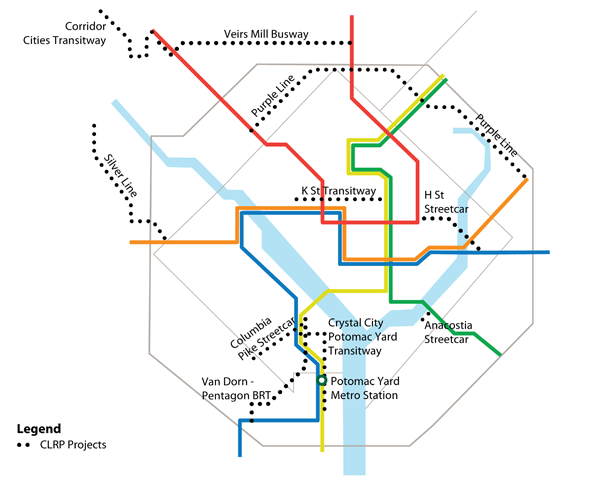Today’s Planned Transportation Investments – the Constrained Long Range Plan (CLRP)
The National Capital Region Transportation Planning Board (TPB), the region’s Metropolitan Planning Organization (MPO), adopts the region’s constrained long-range plan (CLRP) annually. Only projects included in this regional transportation plan are eligible for federal funding, and since 1991, federal law requires the CLRP to be constrained financially. This regional transportation plan includes only projects that are reasonably expected to be fully funded.
As shown above, the CLRP includes numerous regionally significant transit investments totaling roughly $7 billion ($2012) to be implemented in the region between 2012 and 2040. These projects have progressed through planning studies to the point where locally preferred alternatives have been identified and funding plans have been developed.
If implemented, the CLRP transit projects will increase transit use in the region, resulting in more transfers to and from Metrorail and Metrobus lines, which are already approaching capacity. Without improvements to the existing system, expectations of mobility improvements or enhanced transit access may lead to increased crowding, accelerated system degradation due to higher usage, and the potential for less-reliable service and more-frequent system interruptions as the existing system becomes overburdened.
Significantly, the current CLRP Financial Plan has insufficient funding to fully support Metro’s projected renewal needs beyond 2020, as well as no funding for Metro core capacity improvements. As a result of the financial shortfall, the CLRP travel forecasts include a transit capacity constraint that limits the growth in transit trips beyond 2020, negatively impacting future traffic congestion and air quality.
The lack of funding in the CLRP to address the backbone of the region’s transit system means that the region’s other transit investments may not perform as expected. Adequate throughput, passenger comfort, and reliability are necessary for Metro’s core to absorb additional demand that will alleviate roadway congestion. Metro’s core capacity needs to be a regional priority in order to manage the expected increases in ridership that will come from these transit expansions.
For more information:
Download both the full Momentum plan and the Executive Summary.
Regional support is important to making Momentum a reality! A number of regional stakeholders have already endorsed Momentum. Please sign on and add your name to endorse Momentum and send the message that public transit is vital to the National Capital Region.


While I agree that these projects make Momentum all the more important, does WMATA have an idea of how much some of these projects will actually shift demand off of the Metrorail system? I could see the Purple Line and streetcars, Van Dorn BRT, and Crystal City Transit Way all shifting at least some trips off of the system.